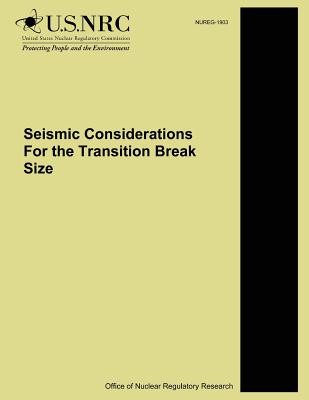
- We will send in 10–14 business days.
- Author: U S Nuclear Regulatory Commission
- Publisher: CreateSpace Independent Publishing Platform
- Year: 2014
- Pages: 104
- ISBN-10: 1500615099
- ISBN-13: 9781500615093
- Format: 21.6 x 28 x 0.6 cm, softcover
- Language: English
- SAVE -10% with code: EXTRA
Seismic Considerations For the Transition Break Size (e-book) (used book) | bookbook.eu
Reviews
Description
The U.S. Nuclear Regulatory Commission (NRC) has been considering revision of the regulatory requirements for the emergency core cooling system (ECCS), as set forth in Title 10, Section 50.46, of the Code of Federal Regulations (10 CFR 50.46); Appendix K to 10 CFR Part 50; and General Design Criterion (GDC) 35. In particular, those requirements state that the ECCS shall be sized to provide adequate makeup water to compensate for a break of the largest diameter pipe in the primary system [i.e., the so-called "double-ended guillotine break" (DEGB)]. Consequently, in order to risk-inform the break size, the staff of the NRC proposed the concept of transition break size (TBS). In addition, the NRC developed pipe break frequencies as a function of break size using an expert elicitation process for degradation-related pipe breaks in reactorcoolantsystemsoftypicalboiling-andpressurized-waterreactors. Thatelicitationfocusedon determining event frequencies that initiate by unisolable primary side failures that can be exacerbated by material degradation with age under normal operating conditions. The purpose of this study was to assess potential seismic effects on the postulated TBS, and to provide information to facilitate review and comment regarding the proposed risk-informed revision of ECCS requirements in 10 CFR 50.46. Thus, this report evaluates the seismic effects, using different approaches to evaluate flawed and unflawed piping, and indirect failures of other components and component supports that could lead to piping failure.
EXTRA 10 % discount with code: EXTRA
The promotion ends in 19d.08:43:15
The discount code is valid when purchasing from 10 €. Discounts do not stack.
- Author: U S Nuclear Regulatory Commission
- Publisher: CreateSpace Independent Publishing Platform
- Year: 2014
- Pages: 104
- ISBN-10: 1500615099
- ISBN-13: 9781500615093
- Format: 21.6 x 28 x 0.6 cm, softcover
- Language: English English
The U.S. Nuclear Regulatory Commission (NRC) has been considering revision of the regulatory requirements for the emergency core cooling system (ECCS), as set forth in Title 10, Section 50.46, of the Code of Federal Regulations (10 CFR 50.46); Appendix K to 10 CFR Part 50; and General Design Criterion (GDC) 35. In particular, those requirements state that the ECCS shall be sized to provide adequate makeup water to compensate for a break of the largest diameter pipe in the primary system [i.e., the so-called "double-ended guillotine break" (DEGB)]. Consequently, in order to risk-inform the break size, the staff of the NRC proposed the concept of transition break size (TBS). In addition, the NRC developed pipe break frequencies as a function of break size using an expert elicitation process for degradation-related pipe breaks in reactorcoolantsystemsoftypicalboiling-andpressurized-waterreactors. Thatelicitationfocusedon determining event frequencies that initiate by unisolable primary side failures that can be exacerbated by material degradation with age under normal operating conditions. The purpose of this study was to assess potential seismic effects on the postulated TBS, and to provide information to facilitate review and comment regarding the proposed risk-informed revision of ECCS requirements in 10 CFR 50.46. Thus, this report evaluates the seismic effects, using different approaches to evaluate flawed and unflawed piping, and indirect failures of other components and component supports that could lead to piping failure.


Reviews